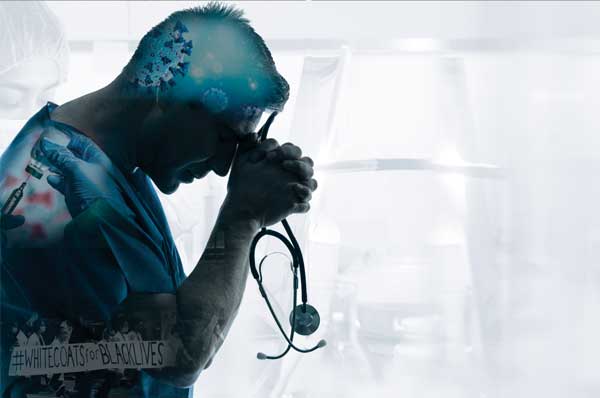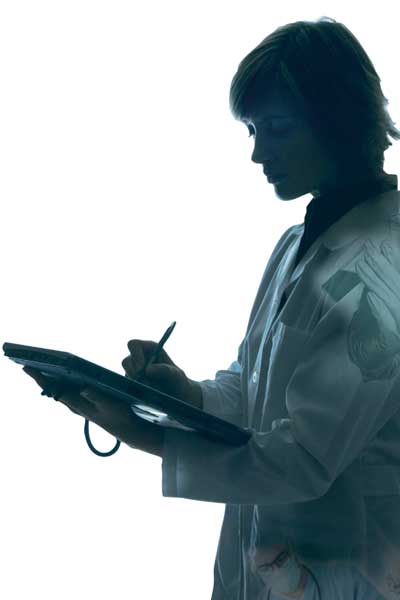Reimagining Public Health
Pivoting from Pandemic Response to Future Prevention
July 6, 2021by Janice Fisher
The broad landscape of public health, and the specific domain of clinical trials,
resonate with once-in-a-lifetime force in year 2 of COVID-19. Here, four PCOM alumni
describe how their work and their workplaces are drawing on and pivoting from a pre-pandemic
baseline to prepare themselves and those they serve for what may be next.
“In public health, the population is our patient,” says Lauren B. Ball, DO ’95, MPH, FAOCOPM, assistant professor, PCOM Georgia, and course director for the Preventive and Community-Based
Medicine course required for all Doctor of Osteopathic Medicine (DO) candidates. In that role, Dr. Ball’s mission is to “make public health concepts relevant
to students in whatever specialty of medicine they plan to pursue.”
From that perspective, the COVID-19 pandemic was an extraordinary teaching opportunity.
“The concepts were playing out in real life, affecting the students and their families.
We saw different approaches to the pandemic in different parts of the country, and
still other approaches internationally. Disease control efforts involve elements of
individual and social responsibility, which at times can conflict with personal freedoms.”
A balancing act
Dr. Ball describes public health as a balancing act, with science overlain by politics
and economics, noting that “the public health response to an outbreak or pandemic
continually evolves as we gather more information and allocate funding.”
Dr. Ball has herself been part of such responses. At the Centers for Disease Control
and Prevention (CDC), she was in the Epidemic Intelligence Service, and her work as
a staff member was supported by the beginning of the funding of public health preparedness.
“Under the umbrella category of bioterrorism, we worked to bolster the essential activities
that public health departments do every day: surveillance, lab testing, finding cases,
tracing contacts, and recommending non-pharmaceutical interventions such as social
distancing, quarantine and isolation.”
At the Florida Department of Health, Dr. Ball was involved in the mass vaccination
response to the H1N1 influenza pandemic in 2009. Later, as the deputy state epidemiologist
for the Maine Center for Disease Control, she worked on a response to a novel variant
of swine influenza.
Public health concepts for DO students
“I remind students,” Dr. Ball says, “that they are required to work with the public
health department, as mandated by law, in managing cases of communicable disease.
The health department is a resource for clinicians, providing important information
in the form of health alerts and guidance documents that support communicating with
patients about prevention measures that will impact personal health as well as the
health of the community.
“Public health also deals with chronic disease,” she adds, “and it’s up to clinicians
to help communicate with their patients about lifestyle changes that would impact
their health.” Chronic disease and infectious disease can intersect; the morbidity
and mortality related to COVID demonstrated the “disproportionate impact on those
segments of the population that suffer from certain chronic diseases. The burden of
disease was not spread equally, which also illustrated the impact of the social determinants
of health, including access to care.”
Vaccine hesitancy has been widely discussed during the COVID pandemic. “Who better
to give someone science-based information than their personal clinician?” Dr. Ball
asks. She introduced her students to apps and websites that help clinicians frame
such conversations, pointing out that evidence-based practices exist not only in medicine,
but also in public and community health.
“Yes, we are in unprecedented times,” says Dr. Ball, “but we constantly learn from
our past responses about what worked and what didn’t. What we will learn from COVID
will help us plan for future events to be able to implement successful, timely interventions.”
In February 2020, the 15-year-old clinical trial research company IACT Health had
69 concurrently enrolling research trials in over 30 different medical therapeutic
areas—oncology, nephrology, cardiology and more—but very little vaccine work or medical
device work, and virtually no prescreening activities, like community health fairs.
“On March 13, 2020,” recalls Jeffrey Kingsley, DO ’01, MBA, CPI, FACRP, founder and CEO, “we got our first email saying, ‘Stop immediately. This trial is
on hold until further notice.’ Within four weeks, 60 percent of our business had been
suspended.”
The company invested in lab equipment and hired a new “swab squad” to do free COVID
testing in their redesigned parking lot. In the process, they pivoted into new research
areas and subsequently built out a new division around vaccine research and medical
device research. They invested in doing more gastroenterology research to leverage
the success of the COVID work.
Today, the company has over 120 concurrently enrolling trials and manages about 400
concurrent trials. But “our passionate cause,” says Dr. Kingsley, “is revolutionizing
research. How do we get more physicians involved, more patients? How do we make research
happen faster?”
The future of research: Direct to patient
COVID has dramatically accelerated industry interest in direct to patient clinical
trials, also called decentralized or virtual clinical trials. Dr. Kingsley—despite
having built a brick and mortar business—has long believed they are the future of
research. “Why should I make you come to my building to be able to participate? The
vast majority of patients who enter trials are within a five-mile radius of an office.”
As a result of the pandemic, “All of a sudden, we see home health nursing being able
to facilitate getting patient bloodwork. All of a sudden, couriers can deliver a drug
to a patient’s home and bring the labs back to us, we process the labs, and the courier
does the shipping for us.”
In two vaccine projects currently enrolling throughout the United States, “patients
will never have to meet me in person,” says Dr. Kingsley, “but I can jump on a call
with them, or a telemedicine visit—for example, to help them understand the informed
consent process. This dramatically enhances our ability to enroll those projects,
and now patients in remote areas can participate, whereas they wouldn’t have had the
opportunity otherwise.”
Solving the program of too few PIs
Patient availability isn’t the only challenge in clinical trial research. “Today there
are too few experienced principal investigators (PIs),” says Dr. Kingsley. “The churn
rate of physicians in clinical research is 51 percent—almost the same as waitstaff
in a restaurant. Most sites are very small, poorly run businesses, with doctors still
trying to do this as a hobby.
“The solution is to design a system that allows physicians to thrive doing research
long-term as part of their career trajectory. Doing direct to patient work effectively
means you need fewer PIs, because now one PI can serve an entire state. And so direct
to patient enables us to more effectively access the greatest, most experienced PIs.”
“‘Necessity is the mother of invention’ is not quite true,” Dr. Kingsley observes.
“Pain is the mother of invention. COVID was painful enough that it made the industry
adopt direct to patient methods. And ultimately that’s the silver lining.”
Jacky So, MS/Biomed ’16, works at a company that didn’t exist before the pandemic. Mrs. So is director of
technical program managers at Primary.Health in San Francisco, a cloud-based data
platform startup focused on software solutions for testing and vaccination programs.
Begun by a group of volunteers initially seeking to increase COVID-19 testing and
tracing efforts in Northern California, the company has grown from eight people to
over one hundred.
Mrs. So describes the platform as “lab agnostic, requisitioning physician agnostic,
test agnostic—we enable any size group, organization, business, school, community,
research lab, you name it, to use our platform. Our platform is modular and flexible,
which allows us to adapt and customize the end-to-end process to their needs.” Primary.Health
is committed to inclusivity and social determinants of health, both through their
platform’s design and functionality and through their focus on providing services
to areas of greatest need, including communities of color.
Seats at the table
“How do we collect data not merely for the sake of collecting it,” asks Mrs. So, “but
to actually bridge gaps in health equity resources?” For Mrs. So, it’s about providing
seats at the table, in multiple ways.
Primary.Health thinks about the experience for both the administrator providing services
and the end participant. For example, administrators might want updated insurance
information if it exists, so they can enable a feature that allows collecting such
information at the point of service. But Primary.Health “doesn’t prioritize insurance
as a gatekeeping mechanism to deny somebody access to services they need. People move.
People have lost their jobs during the pandemic, and their insurance is tied to their
jobs. By allowing insurance to be secondary to what we do, we are able to prioritize
the right things and serve as a conduit for groups to reach their populations of interest.
“Our research partners are doing multiyear longitudinal studies of communities that
might not have great Wi-Fi or access to internet.
“Many research tools were built decades ago; everything’s just text. And if that text
is English-only, it’s already excluded people before a study ever started. It also
excludes people on the patient end, who might have to call a helpline, resulting in
a backlog of calls—it’s a broken system, but it just keeps being done that way. And
so that’s where we enter.”
Customizing and moving forward
The company can visualize data of interest and generate highly customized reports—maybe
one way for a study, a different way for a lab, for a board of directors, to meet
federal reporting requirements. “We support multiple languages and translations, and
every group, every study, has custom needs,” says Mrs. So.
During the winter holiday season, Mrs. So saw a support ticket for an airline passenger
trying to fly home to Hong Kong. The airline wanted a lab report PDF, which the lab
needed to generate ad hoc but wasn’t permitted to send by email. Mrs. So “coded something
up and got the signoff from the lab”—transitioning the manual lab report generation
into an automated custom report on the patient’s secured results page that even included
specific terms the airline wanted. “I learned later that everyone else was stuck at
the airport because their lab reports did not show the specific items we were able
to include, but we helped that person get home. Thanks to this collaboration during
peak travel and varying country restrictions, the auto-generated lab reports during
this time have been self-sustaining to help others as well.”
As the U.S. emerges from the pandemic, Primary.Health “can package what we’ve done
to support other research efforts and countries,” says Mrs. So. “If we look around
the world, it’s going to take all of us to move the future of data, science and equity
forward.”
Five Questions for Lauri A. Hicks, DO ’99
Captain, US Public Health Service; Director, Office of Antibiotic Stewardship, Division
of Healthcare Quality Promotion, Centers for Disease Control and Prevention
How did you become interested in epidemiology as a career? What propelled you from
the University of Connecticut and PCOM to the CDC?
“I always was very interested in disease prevention and health promotion, even while
in college. I really liked the osteopathic approach and philosophy, especially the
emphasis on disease prevention, and PCOM was not far from my family in Pennsylvania.
PCOM was the only medical school I applied to.
During my clinical years, I enjoyed the process of thinking through challenging cases,
which led me to internal medicine. It wasn’t until I arrived in my internal medicine
residency at UConn that I seriously considered public health as a career path. I had
several excellent mentors, including Drs. Richard Garibaldi (chairman of Internal
Medicine at the time) and Jack Ross, both infectious diseases physicians who told
me I should look into the Epidemic Intelligence Service (EIS) program, a two-year
applied epidemiology and disease detective training program at CDC. This was an opportunity
to apply my interests in disease prevention at a population level.
I applied to the EIS program during my chief residency year. I subsequently did an
infectious diseases fellowship at Brown University, but I returned to CDC permanently
in 2007 to work for the Respiratory Diseases Branch. I now lead the Office of Antibiotic
Stewardship in the Division of Healthcare Quality Promotion. It’s hard to believe
that I have now been at CDC for nearly 16 years!”
What is your role now in your COVID deployment?
“I have been working almost continuously on CDC’s COVID-19 pandemic response since
March 2020. I deployed initially to lead CDC’s Deployment Assessment and Monitoring
Team for nearly 10 months. In that role, I was responsible for monitoring for COVID-19
among CDC staff and protecting the health of CDC’s workforce. I also provided consultation
to several other federal partners, including FEMA and the Department of Homeland Security.
In the months after that deployment, I served in a clearance role reviewing content
pertaining to healthcare infection prevention and control and COVID-19.
I just started in a new role as the Chief Medical Officer for the Vaccine Task Force.
My team is responsible for monitoring the safety of the COVID-19 vaccines, responding
to clinical inquiries, and developing guidance and policy on vaccine administration
with input from the Advisory Committee on Immunization Practices. This is both a daunting
and exciting role, and I feel honored to have the opportunity to work with so many
passionate colleagues on the response.”
How do the core elements of the CDC’s antibiotic stewardship in various healthcare
settings play out in dealing with the “just in case” overuse of antibiotics in COVID
treatment?
“Antibiotics are frequently prescribed for respiratory conditions for which they provide
no benefit and can cause harm. Although overall antibiotic prescribing decreased during
the pandemic, prescribing of specific antibiotics, including azithromycin, was higher
than expected. Patients who develop secondary bacterial infections after COVID-19
infection may require antibiotic treatment, but current data suggest this occurs in
only 5.9 percent of patients presenting to hospitals with a current or recent COVID-19
diagnosis.
CDC’s Core Elements of Antibiotic Stewardship offers healthcare professionals and
antibiotic stewardship leaders a set of key principles to guide efforts to improve
antibiotic use. Tracking and Reporting are CDC core elements. In places where these
core elements are being actively implemented, we haven’t seen the same kinds of increases
in azithromycin use. For example, one of our partners, Intermountain Healthcare, instituted
a multifaceted intervention from July 2019 to June 2020, including robust tracking
of antibiotic prescribing and feedback of prescribing practices to clinicians. While
an increase in azithromycin use was seen nationally, their network of urgent care
centers saw a decrease in azithromycin for respiratory visits from 9.7 percent of
visits down to just 3.3 percent of visits during the pandemic.”
How will US Antibiotic Awareness Week at the end of November be shaped by the pandemic?
“The pandemic has had a significant impact on antibiotic prescribing, and we plan
to communicate about what we have learned about prescribing during this time. During
2020, outpatient antibiotic use was much lower than it has been in previous years,
which we believe is due to decreases in healthcare utilization, decreased transmission
of non-COVID-19 illnesses, and increased awareness that viruses aren’t treated by
antibiotics. In hospitals, we have seen increases in use of antibiotics that are normally
prescribed for treatment of community-acquired pneumonia. This is not surprising given
the high frequency of COVID-19 admissions and associated respiratory illness.
Since most patients with COVID-19 don’t have bacterial co-infections, there are likely
opportunities for antibiotic stewardship programs to reduce unnecessary antibiotic
use. We are hopeful that some of the knowledge gained related to managing viral infections
will ultimately lead to improvements in antibiotic use.”
How might the experience and lessons of COVID be manifested in the work and mission
of the Office of Antibiotic Stewardship post-pandemic?
“The pandemic has changed so much about healthcare delivery in such a short time,
and we must both adjust to this new normal and take lessons learned to move forward.
Telehealth is a growing and important part of our healthcare delivery system, and
my team is working to identify the best approaches to optimizing antibiotic use in
telehealth.
At the same time, the pandemic has made health disparities that exist in our country
even more apparent, and one of our priorities is to identify and address health disparities
that may lead to differences in the quality of antibiotic prescribing in different
populations.
We also know that we must work with our partners to build more resilience into our
antibiotic stewardship programs and activities, especially at the local level, so
that this important work can continue even when there is a public health emergency.”
|
About Digest Magazine
Digest, the magazine for alumni and friends of Philadelphia College of Osteopathic Medicine,
is published by the Office of Marketing and Communications. The magazine reports on
osteopathic and other professional trends of interest to alumni of the College’s Doctor of Osteopathic Medicine (DO) and graduate programs at PCOM, PCOM Georgia and PCOM South Georgia.

 “In public health, the population is our patient,” says Lauren B. Ball, DO ’95, MPH, FAOCOPM, assistant professor, PCOM Georgia, and course director for the Preventive and Community-Based
Medicine course required for all
“In public health, the population is our patient,” says Lauren B. Ball, DO ’95, MPH, FAOCOPM, assistant professor, PCOM Georgia, and course director for the Preventive and Community-Based
Medicine course required for all  “Yes, we are in unprecedented times,” says Dr. Ball, “but we constantly learn from
our past responses about what worked and what didn’t. What we will learn from COVID
will help us plan for future events to be able to implement successful, timely interventions.”
“Yes, we are in unprecedented times,” says Dr. Ball, “but we constantly learn from
our past responses about what worked and what didn’t. What we will learn from COVID
will help us plan for future events to be able to implement successful, timely interventions.”